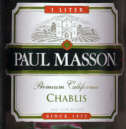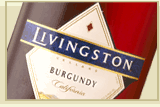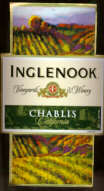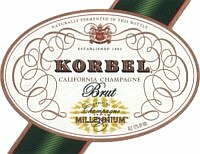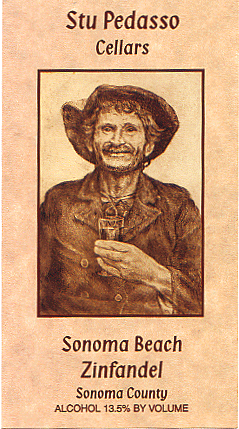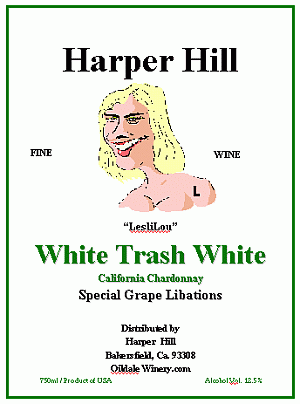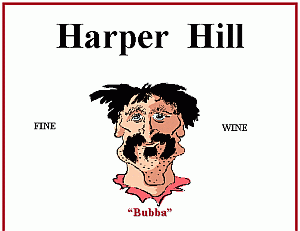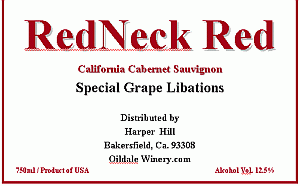If there is no Burgundy
grape,
then
just how can California produce a Burgundy wine? Or a
Chablis? Or a Chianti? The truth is, they cannot.
The truth is they are taking unfair and improper advantage of the
extraordinary reputation developed over the years by these famous
growing regions. Reputations that were earned and recognized
only after decades and decades, and in some cases centuries, of
consistently producing superior quality wines. Some vineyards
in these growing regions date back to the time of Caesar and
Christ.
In addition to California taking indecent liberties with the
names of these great growing regions of the old world,
California also abuses its own fine growing regions. For
example, California vintners will print on their label "Napa
Valley" or "Sonoma” etc. This will lead the buyer to conclude
the wine inside the bottle is a fine wine from a great growing
region when in fact the grape used to make the wine may have come
from Blythe or Barstow. All the wine maker needs
is a Post Office Box in Napa. Even if the wine was bottled in
Napa or Sonoma, it doesn't mean the grapes came from there.
This miscreation is a gross injustice to the quality wineries, that
attentively grow, cultivate and harvest their own grapes, and
create their wines all within the legal boundaries of the
appellation on the label.
And, if that is not enough, the vintner will print on the label,
"Reserve,” "Grand Reserve,” "Special Reserve,” "Great Estate"
or some other of several seductive terms, all of which mean
absolutely nothing. Those titles are simple marketing
gimmicks. In France, Italy and Spain those terms and names
are important. They refer to the age of the vine, the number
of vines per acre, the size of the grape, the number of grape
clusters on the vine, the maceration process, the ageing process
and the length of ageing. In California, "Estate Bottled"
does mean something. It means the grape in the bottle must
have come from the vineyard whose name is on the bottle. Well, at
least from the same area as the vineyard. Well, at least 75%
of the grapes.
California has some truly great growing regions. Actually
five. North Coast, Central Valley, Sierra Foothills, Central
Coast and South Coast. The North Coast is, by far, the most
renowned. This region contains the appellations, or
sub-regions, of Napa, Sonoma, Mendocino, Alexander Valley and the
Russian River Valley. California's finest wines are produced
in this area. I don't wish to denigrate the Central Coast
which include the fine regions of Paso Robles and the wonderful
Santa Maria Valley.
It just amazes me that the wineries of those fine appellations do
not negotiate with the American Viticultural Area (AVA) and demand
enforcement of the very simple regulations for labeling wine.
The losers in this situation are the discriminating wineries which
produce the excellent, superior quality wines that come from these
areas yet are bundled in with all of the other inferior,
commercial, second-class and in some cases downright shoddy wines
that come from the same areas, and of course, you and me, the wine
consumer, who will pick up a bottle of California wine and, unless
we are familiar with one or several of the nearly 1,000 wineries,
do not have a clue to its contents.
The problem has to be shared with the premium wineries who refuse
to expend the effort for proper classification, the shoddy wineries
who wish to remain buried in the glamor of Napa, Sonoma, etc. and
the United States government. The AVA comes under the
jurisdiction of the Bureau of Alcohol, Tobacco and Firearms.
(BATF) The BATF is a law enforcement agency designed to
collect taxes or catch crooks such as smugglers who try to avoid
taxes. Moonshiners!
The French "Appellation d'Origine Controlle" (AOC) and the Italian
"Denominazione di Origine Controllata" (DOC) are government law
enforcement agencies who are NOT interested in collecting taxes or
capturing "moonshiners" but are concerned only with insuring that
what the winery puts on the label is what the winery puts in the
bottle. For example, if a French winery places "Pauillac" on
its label, you are guaranteed that the grapes were grown in a
vineyard in Pauillac, the wine was macerated, aged and bottled in
Pauillac and it was all processed under very strict conditions
which will produce the wines for which this appellation is
famous. The "Pauillac" appellation consists of 2,400 acres
and is inside the Haut Medoc region, which is inside the Medoc
region, which is inside the Bordeaux region. You know exactly
where the grapes and the wine came from. Should the winery wish to
place "Reserve" on the label, the wine must be aged, in oak
barrels, an additional (depending upon the appellation) three to
twelve months. If they wish to place "Grand" or "Special"
reserve on the label, the wine must be aged, in oak barrels, an
additional three to twelve months beyond the required "Reserve"
ageing. The AOC and the DOC even dictate the age of the vine, the
size of the grape, the number of grapes on the stem, the number of
vines per acre, the maceration process, the ageing process,
the length of ageing, what kind of container the wine is aged in
and if the oak barrels are to be new or used.
Those law enforcement agencies, AOC and DOC, were created
specifically to guarantee (vintage variations aside) the quality of
the wine.
The BATF guarantees the taxes were collected. |
